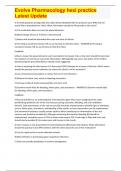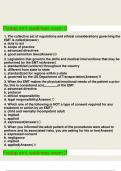Evolve Pharmacology hesi practice
Latest Update
A 35-week gestation primigravida who takes lithium (Eskalith) tells the practical nurse (PN) that she
would like to breastfeed her infant. What information should the PN provide to the client?
A) The medication does not cross the placental barrier.
B) Mood swings will occur if lithium is discontinued.
C) Breast milk should be discarded after each oral dose of lithium.
D) The drug is excreted in breast milk so use formula to feed the infant. - ANSWER-D) The drug is
excreted in breast milk so use formula to feed the infant.
Feedback:
Lithium crosses the placental barrier and is excreted in the breast milk, so the client should formula feed
her newborn. (A and C) are inaccurate information. Although (B) may occur, the option of the mother
discontinuing the prescribed lithium should not be suggested.
A client is receiving the third course of 5-fluorouracil (5FU) therapy for a tumor of the liver. Which action
should the practical nurse implement to reduce the client's risk for stomatitis?
A) Use commercial oral products to reduce the risk of oral infections.
B) Observe for black, tarry stools or bleeding ulcerations.
C) Increase intake of foods containing fiber and citric acid.
D) Examine mouth daily for bleeding, white spots, and ulcerations. - ANSWER-D) Examine mouth daily
for bleeding, white spots, and ulcerations.
Feedback:
5-fluorouracil (5FU) is an antimetabolite, antineoplastic agent that causes sloughing of the rapid
proliferating epithelial cells of the oral mucosa causing ulceration, bleeding, and oral candidiasis
(thrush). Daily examination of the oral mucosa (D) should be implemented to identify signs of stomatitis,
such as white spots, ulcerations, and bleeding of the mouth, so early intervention can be implemented.
Oral commercial products usually contain alcohol, which contributes to inflammation of the oral
mucosa, and should be avoided (A). Although monitoring the stool for bleeding (B) should be
implemented, stomatitis occurs in 75% of clients who receive 5FU. Foods high in fiber and citric acid
should also be avoided (C) to reduce pain and trauma to the mouth.
A client receives a new prescription for beclomethasone (Beclovent Oral Inhaler). What information
should the practical nurse (PN) reinforce with the client about the use of this medication?
A) Use for rapid results in acute asthmatic attacks.
B) Most effective in preventing upper respiratory infections.
C) Daily use provides prophylaxis in asthma management.
,Evolve Pharmacology hesi practice
Latest Update
D) Inhale when exposed to allergens in the environment. - ANSWER-C) Daily use provides prophylaxis in
asthma management.
Feedback:
Beclovent Oral Inhaler, an inhaled glucocorticoid, is used for prophylaxis in the management of chronic
asthma (C) and should be administered on a fixed schedule, not (D). Inhaled beta 2 agonists, not a
glucocorticoid, work rapidly in acute asthma attacks (A) precipitated by environmental allergen
exposure (D).
A client receives a prescription for an oral opioid analgesic for post-operative pain. Which adverse effect
should the practical nurse (PN) monitor for with the client?
A) Constipation.
B) Photosensitivity.
C) Decreased heart rate.
D) Frequent urination. - ANSWER-A) Constipation.
Feedback:
Opioid analgesics slow peristalsis, which leads to constipation (A), a common side effect of opiates. (B, C,
and D) are not associated with opioid analgesics.
A client receives a prescription for clotrimazole 1% (Gyne-Lotrimin) vaginal cream for Candidiasis. Which
information should the practical nurse provide the client?
A) Discontinue medication if menstruation begins.
B) Instill cream using the intravaginal applicator each night for 7 days.
C) Use daily douching as part of the treatment for vaginal yeast infections.
D) Abstain from sexual intercourse until treatment is completed. - ANSWER-B) Instill cream using the
intravaginal applicator each night for 7 days.
Feedback:
The intravaginal cream should be instilled each night for 7 days to complete the medication (B) even if
symptoms are relieved. Medication should be continued until it is completed, even during menstruation
(A). Douching (C) is contraindicated. Abstinence (D) is not required.
A client receives a prescription for nystatin (Mycostatin) oral suspension for the treatment of oral
thrush. Which information should the practical nurse (PN) provide?
A) Take on an empty stomach.
B) Mix the suspension with water.
, Evolve Pharmacology hesi practice
Latest Update
C) Swish then swallow the medication.
D) Keep in the refrigerator. - ANSWER-C) Swish then swallow the medication.
Feedback:
The client should swish the suspension in the mouth for as long as possible before swallowing it (C). The
method of swish and swallow distributes the medication within the oral cavity to ensure topical
coverage of the affected mucosal surfaces. Although (A, B, and D) are medication administration
instructions, swish and swallow is the most specific administration information for nystatin.
A client who has been taking phenazopyridine (Pyridium) for symptoms of urethritis and cystitis comes
to the clinic because her urine is reddish-orange. Which question should the practical nurse ask to
determine if the medication has been effective?
A) How much water have you been drinking each day?
B) Does the urine color stain your toilet bowl or undergarments?
C) Have you had any relief from urinary pain, burning, or urgency?
D) Did your urine appear cloudy or have a foul odor on voiding? - ANSWER-C) Have you had any relief
from urinary pain, burning, or urgency?
Feedback:
Phenazopyridine, an over-the-counter urinary analgesic, acts on the mucosa of the urinary tract to
relieve urinary pain, burning, itching, or urgency (C) associated with urethritis and cystitis. Although
determining if the client is forcing fluids (A), experiencing staining from Pyridium's side effect (B), or
having signs of a urinary infection (D) are worthwhile assessments, the therapeutic response of Pyridium
is related to urinary discomforts only.
A client who is comatose is admitted after an overdose of baclofen (Lioresal). What nursing action
should the practical nurse (PN) implement?
A) Provide continuous telemetry monitoring.
B) Monitor for signs of respiratory arrest.
C) Administer prescribed naloxone (Narcan).
D) Keep a dose of diazepam at the bedside. - ANSWER-B) Monitor for signs of respiratory arrest.
Feedback:
An overdose of baclofen (Lioresal), a centrally acting muscle relaxant, can cause coma and respiratory
depression that requires respiratory support. Monitoring for early signs of respiratory arrest (B) is most
important so immediate respiratory resuscitation can be provided. Although telemetry (A) provides
close cardiac monitoring, early recognition of respiratory arrest is indicated due to the actions of
Lioresal. Narcan (C) is ineffective for baclofen overdose. (D) is not indicated.





